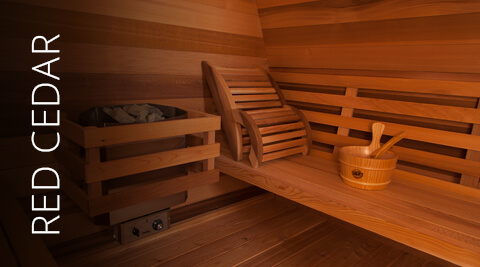The Only Guide for Traditional Sauna
The Only Guide for Traditional Sauna
Blog Article
Traditional Sauna - Truths
Table of ContentsRumored Buzz on Traditional SaunaTraditional Sauna Can Be Fun For EveryoneFascination About Traditional SaunaGet This Report about Traditional Sauna
The majority of the weight shed in a sauna is water loss and is re-gained upon rehydrating. However, without a question sauna can be a crucial part of a healthy weight reduction program. To take a look at the distinctions between typical and IR saunas, I will certainly divide these right into verifiable, theoretical, and made distinctions.Therefore, the hottest point in the saunawhich goes to the ceiling straight above the sauna heateris typically between 185 and 190 F. Traditional Sauna. Claims that a conventional sauna surpasses 200 F is merely not real and not relevant for electrical saunas offered in the United States. The temperature for a far-infrared sauna is normally set in between 120 and 140 F; nevertheless, unlike the conventional sauna, the goal in and IR area is not to accomplish a heat
As a result of this, the temperature level difference is virtually unnecessary, considering that excessive sweating results in both sauna kinds, however the method of warming the body is different. In an IR sauna the bather will certainly really feel hot and will certainly sweat a lot, however at much lower temperatures. Thus, if the goal is to invest longer amount of times in the sauna, the IR sauna is a great choice.

The Ultimate Guide To Traditional Sauna
When the heat is accomplished, the aspects cycle on and off to keep the high temperature. A lot of standard sauna individuals enjoy putting water over the rocks to develop vapor to elevate sauna moisture degrees. The advantages of pouring water over the rocks include: making the room much more comfy, dampening the nasal passages, and enabling the use of aromatherapy by blending necessary oils with the water.
In a far-infrared sauna, the warm waves penetrate the body to effectively heat up the body and elevate the body core temperature. To achieve this enhanced temperature, Far-infrared emitters produce infrared power which is close to the very same wavelength as that which the body normally emitsoften described as the "Essential Range" of 7 to 14 microns), so the power is well gotten by the body.
When the energy goes into the body, it causes the body temperature to raise and ultimately causes sweating. In an infrared sauna it is essential for the emitters/heaters to remain on nearly frequently. Since there is no mass of rocks to retain warm, the sauna will certainly cool down if the emitters closed off.
As mentioned over, the sauna bather in an infrared area wants to position himself before operating emitters to obtain maximum benefit from the heat. The home heating time for the two areas can be extremely various, relying on how the areas are utilized. For a typical sauna, a bather must enable 30-40 mins for the room to attain a preferred temperature and to effectively pre-heat the rocks.
Some Of Traditional Sauna
A well constructed sauna will generally achieve a temperature of 150-160 F in about 30-40 mins. For hotter temperature levels, the space might need to warmth for a longer period.
To some, 15 minutes was "thrown away" while the infrared energy heated up the wood panels instead than heating up a body, while others find a pre-heated room to be more comfortable and think an elevated starting temperature level is needed to begin sweating. The size of recommended use for each area is about the exact same (10-15 mins per session); nevertheless, due to the reduced air temperatures and the ability to news really feel the effects of infrared heat much faster than a typical sauna, it is not uncommon for a person to invest an overall of 20-30 mins in an infrared sauna.
Conventional saunas tend to be larger (for this reason make use of more electricity) than infrared saunas, although traditional saunas are certainly readily available in one and two person sizes. For a two-person standard sauna, 5x6 or 5x7 size is most popular. The Get the facts top bench can conveniently seat 2 or three people and is likewise long sufficient to lie down throughout the sauna session.


The typical price per kWH of electrical energy in the united state is around $0.11, so a 4.5 kW heating system will certainly set you back roughly $.50 to run for one hour, if the heating unit runs constantly for one hour. Normally a sauna heating unit will certainly compete 75% of the first hour and 50% of succeeding hours on given that the aspects cycle once the established temperature is attained.
How Traditional Sauna can Save You Time, Stress, and Money.
A 2 person far-infrared room is usually literally smaller than a standard sauna, typically regarding 4' x 4' or smaller. The IR heating unit is generally 1.5-1.7 kW utilizing a 120 volt 15 amp plug-in solution. Because the space can be made use of quicker than a sauna room, we will assume the area is made use of for to of an hour consisting of heat up time.
There is a seldom talked about distinction in the social experience between the two spaces. While our culture has shed a few of the social benefit of the standard sauna experience, it can be really socially fulfilling. From family members my link time in the sauna, to heart-felt discussions with loved ones, to sauna partiesthe conventional sauna experience can bring about intimate socializing.
A lot of greater end infrared rooms consist of tinted light treatment, audio systems and full-glass fronts.
Report this page